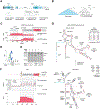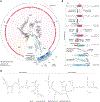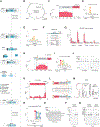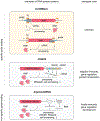The widespread IS200/IS605 transposon family encodes diverse programmable RNA-guided endonucleases
- PMID: 34591643
- PMCID: PMC8929163
- DOI: 10.1126/science.abj6856
The widespread IS200/IS605 transposon family encodes diverse programmable RNA-guided endonucleases
Abstract
IscB proteins are putative nucleases encoded in a distinct family of IS200/IS605 transposons and are likely ancestors of the RNA-guided endonuclease Cas9, but the functions of IscB and its interactions with any RNA remain uncharacterized. Using evolutionary analysis, RNA sequencing, and biochemical experiments, we reconstructed the evolution of CRISPR-Cas9 systems from IS200/IS605 transposons. We found that IscB uses a single noncoding RNA for RNA-guided cleavage of double-stranded DNA and can be harnessed for genome editing in human cells. We also demonstrate the RNA-guided nuclease activity of TnpB, another IS200/IS605 transposon-encoded protein and the likely ancestor of Cas12 endonucleases. This work reveals a widespread class of transposon-encoded RNA-guided nucleases, which we name OMEGA (obligate mobile element–guided activity), with strong potential for developing as biotechnologies.
Conflict of interest statement
Figures






Comment in
-
A treasure trove of molecular scissors.Science. 2021 Oct;374(6563):37-38. doi: 10.1126/science.abm2239. Epub 2021 Sep 30. Science. 2021. PMID: 34591620
-
CRISPR Gets Its Origin Story.CRISPR J. 2021 Oct;4(5):631-633. doi: 10.1089/crispr.2021.29137.knl. CRISPR J. 2021. PMID: 34661430 No abstract available.
-
A vast potential genome editor toolbox.Nat Rev Genet. 2021 Dec;22(12):747. doi: 10.1038/s41576-021-00429-6. Nat Rev Genet. 2021. PMID: 34697494 No abstract available.
References
-
- Zhang F, Development of CRISPR-Cas systems for genome editing and beyond. Quarterly Reviews of Biophysics. 52 (2019).
-
- Hille F, Richter H, Wong SP, Bratovič M, Ressel S, Charpentier E, The biology of CRISPR-Cas: Backward and forward. Cell. 172, 1239–1259 (2018). - PubMed
Publication types
MeSH terms
Substances
Grants and funding
LinkOut - more resources
Full Text Sources
Other Literature Sources
Research Materials

